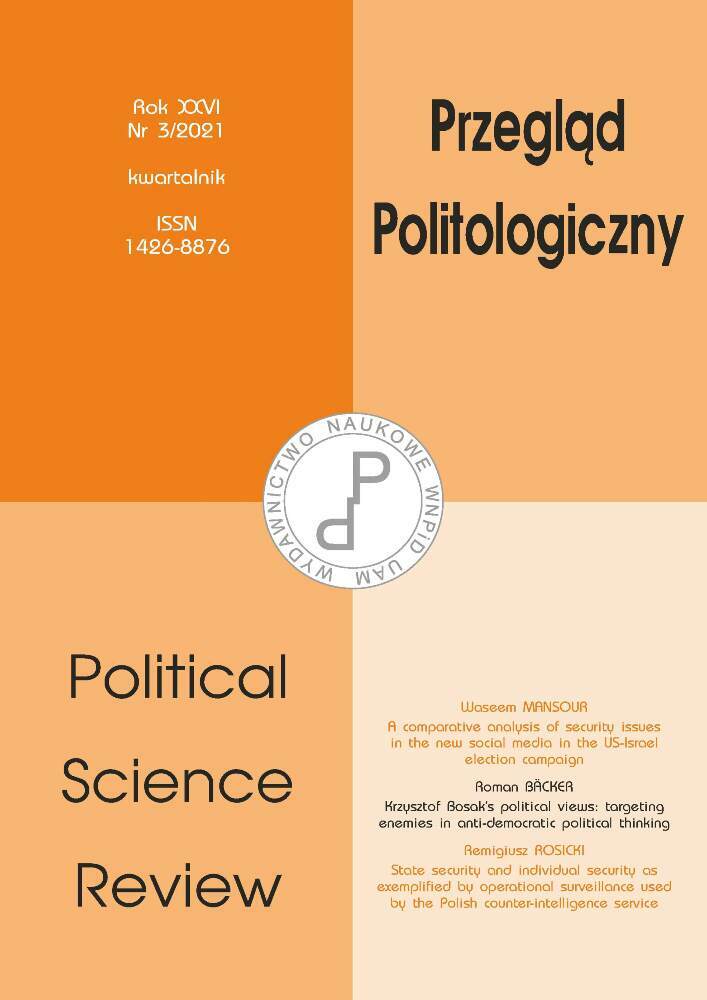Abstrakt
Celem artykułu jest konceptualizacja, to znaczy wyjaśnienie, analiza znaczenia i wskazanie ram interpretacji pojęcia „kryptowaluty” na gruncie nauk społecznych, w tym politologii. Jako zagadnienie interdyscyplinarne, polisemiczne, a zarazem novum technologiczne, kryptowaluty stanowią wyzwanie dla przedstawicieli świata nauki. Zaproponowany heurystyczny model analizy pojęcia oparty o aspekt technologiczny, prawny oraz ekonomiczny wskazuje, że w szerokim ujęciu kryptowalut należy rozumieć jako: zdecentralizowany, funkcjonujący w sieci o architekturze peer-to-peer, zabezpieczony kryptograficznie, oparty na zaufaniu i konsensusie, typ waluty wirtualnej, spełniający w sposób niepełny niektóre funkcje pieniądza. Wyjaśnienie treści poprzez jeden z aspektów funkcjonowania kryptowalut stanowi jego zawężenie.
Finansowanie
Artykuł powstał w ramach realizacji projektu: Postawy polityczne użytkowników kryptowalut w Polsce finansowanego ze środków Narodowego Centrum Nauki, przyznanego w ramach konkursu Preludium 18 na podstawie decyzji numer 2019/35/N/HS5/02222. Kierownikiem projektu jest mgr Wojciech Mincewicz.
Bibliografia
Antonopoulos A. M. (2014), Mastering Bitcoin: unlocking digital cryptocurrencies, “O’Reilly Media, Inc.”, Beijing–Cambridge.
Bashir I. (2017), Mastering blockchain, Packt Publishing Ltd., Birmingham.
Becker J., Breuker D., Heide T., Holler J., Rauer H. P., Böhme R., (2013), Can we afford integrity by proof-of-work? Scenarios inspired by the Bitcoin currency, in: The economics of information security and privacy, pp. 135–156.
Beedham M. (2020), People are obsessed with buing coffee with cryptocurrency – here’s why, April 17, https://thenextweb.com/hardfork/2019/01/31/buying-coffee-bitcoin-cryptocurrency/.
Bentov I., Lee C., Mizrahi A., Rosenfeld M. (2014), Proof of activity: Extending bitcoin’s proof of work via proof of stake [extended abstract] y, “ACM SIGMETRICS Performance Evaluation Review”, 42(3), pp. 34–37.
Chaum D. (1983), Blind signatures for untraceable payment, “Advances in cryptology”, Springer MA, Boston, pp. 199–203.
Chaum D. (1985), Security without identification: Transaction systems to make big brother obsolete, “Communications of the ACM”, 28(10), pp. 1030–1044.
Chen L., Wu H. (2009), The Influence of Virtual Money to Real Currency: A Case-based Study, International Symposium on Information Engineer – ing and Electronic Commerce, Beijing University of Posts and Telecommunications.
Dai W. (1998), B-money, http://www.weidai.com/bmoney.txt.
Dubisz S. (ed.) (2006), Uniwersalny słownik język polskiego PWN [The universal dictionary of the Polish language PWN], vol. 4, Państwowe Wydawnictwo Naukowe, Warsaw.
Directive 2009/110/EC of the European Parliament and of the Council of 16 September 2009 on the taking up, pursuit and prudential supervision of the business of electronic money institutions amending Directives 2005/60/EC and 2006/48/EC and repealing Directive 2000/46/EC.
Dziembowski S., Faust S., Kolmogorov V., Pietrzak K. (2015), August. Proofs of space, in: “Annual Cryptology Conference” (pp. 585–605), Springer, Berlin–Heidelberg.
European Banking Authority (2014), EBA Opinion on virtualcurrencies, July 4, http://www.eba.europa.eu/documents/10180/657547/EBA-Op-2014 08+Opinion+on+Virtual+Currencies.pdf.
European Central Bank (2012), Virtual Currency Schemes, Frankfurt am Main.
European Central Bank (2015), Virtual Currency Schemes – A futher analysis, Frankfurt am Main.
European Parliament resolution of 26 May 2016 on virtual currencies (2016/2007(INI)), 26 May 2016– Brussels, https://www.europarl.europa.eu/doceo/document/TA-8-2016-0228_EN.html.
Houben R., Snyers A. (2018), Cryptocurrencies and blockchain: Legal context and implications for financial crime, money laundering and tax evasion, European Parliament.
Kirillova E., Pavlyuk A. V., Mikhaylova I. A., Zulfugarzade T. E., Zenin S. S. (2018), Bitcoin, lifecoin, namecoin: The legal nature of virtual currency, “Journal of Advanced Research in Law and Economics”, 9(1 (31)), pp. 119–126.
Kochergin D. A. (2017), The roles of virtual currencies in the modern payment system, “St.Petersburg University Journal of Economic Studies” 33(1), pp. 119–140.
Lee Kuo Chien D. (ed.) (2015), Handbook of digital currency: Bitcoin, innovation, financial instruments, and big data, Elsevier Academic Press.
Li W., Andreina S., Bohli J. M., Karame G. (2017), Securing proof-of-stake blockchain protocols, in: Data Privacy Management, Cryptocurrencies and Blockchain Technology, Springer, Cham, pp. 297–315.
Mishkin F. S. (2002), Ekonomia pieniądza, bankowości i rynków finansowych [Economics of money, banking and financial markets], tran. A. Mincewicz, Wydawnictwo Naukowe PWN, Warsaw.
Nakamoto S. (2008), Bitcoin: A peer-to-peer Electronic Cash System, https://bitcoin.org/bitcoin.pdf.
Olnes S., Ubacht J., Janssen M. (2017), Blockchain in government: Benefits and implications of distributed ledger technology for information sharing, “Gov. Inf. Q.” 34: pp. 355–364.
Peters G., Panayi E., Chapelle A. (2015), Trends in cryptocurrencies and blockchain technologies: A monetary theory and regulation perspective, “Journal of Financial Perspectives” 3(3), arXiv preprint arXiv: 1508.04364.
Piech K. (2016) Leksykon pojęć na temat technologii blockchain i kryptowalut [A lexicon of concepts on blockchain technology and cryptocurrencies], Ministerstwo Cyfryzacji, Warsaw.
Pwc. (2014), Virtual currencies: Out of the deep web, into the light.
Redman J. (2020), Wikileaks Gathers $37M in BTC Since 2010 – Over $400K Sent After Julian Assange’s Arrest, February 25, https://news.bitcoin.com/wikileaks-gathers-37m-in-btc-since-2010-over-400k-sent-after-julian-assanges-arrest/.
Rodwald P. (2013), Kryptograficzna funkcja skrótu [Cryptographic hash function], “Zeszyt Naukowy Akademii Marynarki Wojennej” LIV nr 2 (193), pp. 91–102.
Ryfa J. (2014), Waluty wirtualne – problem zdefiniowania i klasyfikacji nowego środka płatniczego [Virtual currencies – the problem of defining and classifying a new means of payment], “Nauka o finansach – Financial Sciences” 2(19), pp. 138–147.
Schaal P. (1996), Pieniądz i polityka pieniężna [Money and monetary policy], tran. M. Rusiński, Państwowe Wydawnictwo Ekonomiczne, Warsaw.
Schollmeier R. (2001), A definition of peer-to-peer networking for the classification of peer-to-peer architectures and applications, “Proceedings First International Conference on Peer-to-Peer Computing”, pp. 101–102.
Shi N. (2016), A new proof-of-work mechanism for bitcoin, “Financial Innovation”, 2(1), p. 31.
Swam M. (2015), Blockchain: Blueprint for a New Economy, “O’Reilly Media, Inc.” Newton MA.
Szabo N. (1997), The God Protocols, https://nakamotoinstitute.org/the-god-protocols/.
The Financial Action Task Force (2014), Virtual Currencies: Key Definitions and Potential AML/CFT Risks, FATF/OECD.
Tucker P. C. (2009), The digital currency doppelganger: Regulatory challenge or harbinger of the new economy, “Cardozo J. Int’l & Comp. L.”, 17, p. 589.
Zacharzewski K., Piech K. (eds.) (2017), Program „od papierowej do cyfrowej Polski” Strumień „Blockchain i kryptowaluty” – przegląd polskiego prawa w kontekście zastosowań technologii rozproszonych rejestrów oraz walut cyfrowych [Program „From paper to digital Poland” Stream „Blockchain and cryptocurrencies” – review of Polish law in the context of the application of distributed ledger technology and digital currencies], https://www.gov.pl/documents/31305/52168/przeglad_polskiego_prawa_w_kontekscie_zastosowan_technologii_rozproszonych_rejestrow_oraz_walut_cyfrowych.pdf/f6e74ce0-09e5-776d-bd3b-c21fca96cce2.
Zadora H. (2015), Podstawowe kategorie finansowe [Basic financial categories], in: Finanse: kategorie, zjawiska i procesy, podmioty, eds. H. Zadora et. al., Publishing House “Difin”, Warsaw, pp. 39–59.

